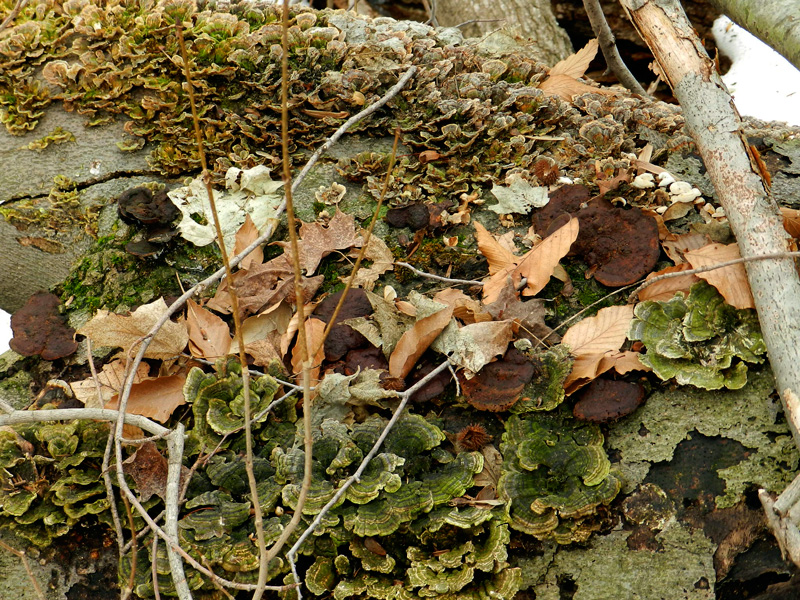
The woods appear dead without being so. The hollowed-out tree is somehow still alive, still standing, all the more impressive for being diseased.

Moss creeps up the base of some trees, and in the moss are tiny flowers, blooming amid the debris that the moss won’t let go of.

The hollows are dank, yet in the dankness the fungus flourish. Parasites, yes, they feast on rot, making exuberant forms and colors out–of–nothing. New life out of death, their variety and beauty as seductive as a vampire movie.

The older the log, the more gloriously diverse the community. Leaves, burrs, dead branches, cluster over the frilly fungi.

Through the dense mat of decay pushes the green force of spring.

harley says
Those are very nice photos of a forest waking up in early, early spring. That old tree looks like it could fall at any time and just barely continues to hang on. Deep and wide, plus thick roots that are hard to uproot. What kind of tree was that?
Celia says
I think it’s a beech. The Warren Woods is a virgin beech forest. The beeches grow to a great height. Their trunks are very straight. But if there is a bad wind storm, the trees sometimes topple over, because the soil they grow in is fairly sandy and augmented only by leaf-rot. It is an impressive sight to see the trees lying their full length on the ground. . . .
harley says
I thought that just maybe, maybe, that picture might have been from the Warren Woods. I’ve been lucky enough to walk through them: yes, a virgin forest in totally pristine condition! The preserve seems to be very large but I think in reality is only 90 acres ???????
Celia says
You can tell a beech forest because all the trees have smooth grey bark. It is a very beautiful sight.
You’ve got me when it comes to the size of the Warren Woods. But it’s true that it seems to be enormous. Certainly, once you get away from the road, you seem to be in a separate world. It is very VERY quiet and almost entirely unfrequented at certain times of the day.
We are coming up on the busy season in the woods, though, because it is a well-known spot for seeing the early wildflowers known as “ephemerals.” These are the flowers that come out before the trees come into leaf. Trillium, rue anemone, marsh marigolds, etc. Between now and late April I imagine these plants will be blooming.
harley says
I just checked via Google. . . . The Warren Woods is 311 acres! I was way off. . . . If possible, I’ll try to get there in late April-early May. . . . Trillium is a very rare plant and only grows in just the “right” conditions. There is a saying that if you see a red or purple trillium it is a sign of good luck and one should make a wish.
Celia says
Michigan is the place to go to see trillium. Some of the preserves in “Harbor Country” are lousy with it in the spring. Breath-taking.
Fernwood Botanical Garden (outside Niles or Buchanan?) is the place to go if you want to see many different kinds. On one of the ravine paths leading down to the river, many different types of trillium grow, and they are labeled–which is a good way to learn what you are seeing. I think 9 or 10 species of trillium grow in our region, some distinguished by their color, the shape of their petals, or the way the flowers hang on the stem.